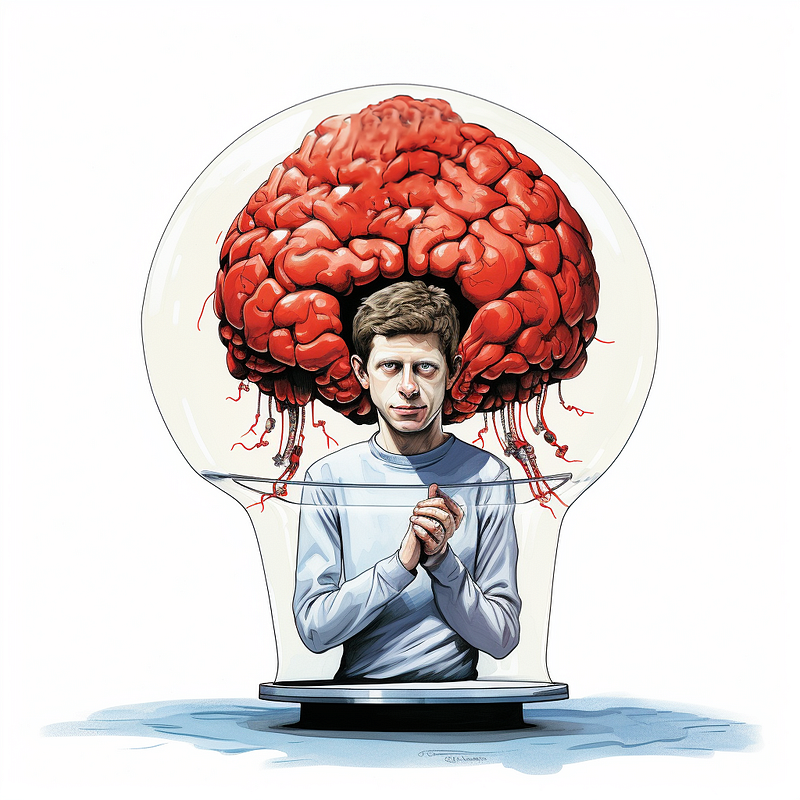Exploring OpenAI's Q*: The Quest for Brain-Like Intelligence
Written on
Chapter 1: The Buzz Around AGI
Earlier this year, Sam Altman, the CEO of OpenAI, sparked widespread speculation in the tech community with a brief Reddit message stating, “AGI has been achieved internally.” This acronym, AGI, refers to Artificial General Intelligence—the ultimate goal in AI research. True AGI would possess brain-like capabilities, including reasoning, creative thinking, and possibly consciousness.
Altman's declaration was monumental; it would be comparable to a prominent scientist announcing that "Fusion works" or a politician claiming, "I’m not running." However, he later clarified that his statement was intended as a joke. Nevertheless, the surrounding drama, especially following his recent dismissal, raises doubts about the light-hearted nature of his claim.
Reports indicate that just before Altman was removed from his position, OpenAI's board received warnings about a significant advancement. Leaked documents hint at a new model, codenamed Q*. Could it be that OpenAI has indeed made strides toward AGI? Let’s delve deeper.
Section 1.1: The Significance of Basic Math
Much of the knowledge surrounding Q* (pronounced Q-star) stems from coverage by Reuters. The outlet interviewed several anonymous sources within OpenAI and accessed internal documents regarding this alleged breakthrough, including a confidential letter addressed to the board by leading scientists.
The reporting indicates that Q* stirred considerable excitement internally because it demonstrated the ability to perform basic arithmetic—something no other Large Language Model had managed before. At first glance, this might not seem groundbreaking. After all, simple calculators have been executing basic math since the 1950s. However, achieving this feat with a Large Language Model represents a significant milestone.
Subsection 1.1.1: A Lesson from Cognitive Science

During my time studying Cognitive Science at Johns Hopkins, I learned from Professor Paul Smolensky, who engaged in a heated debate with a colleague regarding the essence of cognition. This disagreement escalated to the point where his rival published papers titled “Why Smolensky’s Solution Doesn’t Work” and its sequel “Why Smolensky’s Solution Still Doesn’t Work.”
So, what was Smolensky’s proposal? He aimed to clarify how the human brain, composed of interconnected neurons, could perform symbolic reasoning, such as mathematical operations. Symbolic reasoning typically relies on binary computing—a method that processes information systematically to yield a single, precise answer.
Human brains, in contrast, operate differently. Smolensky posited that our brains utilize their complex network of connections for tasks that don’t require precision, like creative thought or visual processing. When symbolic reasoning is necessary, he theorized that our neural network could engage a symbolic “virtual machine,” effectively acting like a binary computer to deliver deterministic answers.
Section 1.2: Q* and Symbolic Reasoning
If the reporting from Reuters holds true, OpenAI may have developed a hybrid system that combines silicon and computer chips, akin to the workings of the human brain. Q*’s ability to perform symbolic reasoning—albeit at a rudimentary level—hints at a potential realization of Smolensky’s vision of a connectionist “virtual computer.”
This model could leverage its unique architecture to engage in creative reasoning while also having the ability to switch to symbolic reasoning for solving specific problems, such as mathematical equations. Therefore, the achievement of basic math capabilities is not the central focus of OpenAI's progress; it signals a significant advancement toward emulating human brain functions.
Chapter 2: The Future of AI with Q*
The first video titled "Did OpenAI Secretly Create a Brain-Like Intelligence After All?" explores the implications of OpenAI's advancements and what they may signify for the future of AGI.
The second video, "What is OpenAI's super-secret Project Q*? | About That," provides insights into the mysterious Q* project and its potential impact on AI technology.
Despite concerns from skeptics, Q* is unlikely to lead to catastrophic outcomes. Even if it has achieved milestones previously exclusive to human cognition, this does not imply that it possesses superintelligence or consciousness, nor is it equivalent to AGI.
What it does indicate, if the reports are accurate, is that OpenAI may have made significant strides ahead of its competitors in developing practical AI systems. A model capable of both intuitive and symbolic reasoning would be immensely valuable in fields like natural language processing, drug discovery, and mathematics—domains that require a combination of creativity and logic.
For instance, understanding language necessitates both comprehension of meaning and mastery of deterministic fundamentals, like grammar. Current LLMs can analyze language statistically, predicting likely word combinations, but they lack a true grasp of the symbolic logic inherent in human languages.
If Q* can successfully merge symbolic and intuitive reasoning, it could deconstruct text into its grammatical elements, fully comprehend context, and generate entirely new ideas unrelated to its training data. This capacity would endow it with remarkable creativity.
Additionally, a system that understands both the deterministic aspects of processes such as protein folding and the more intuitive dimensions of human biology could potentially lead to the rapid development of innovative medicines.
Although Q* may exist, it is unlikely to be available to the public soon. While it has the potential to transform drug discovery and creative processes, it could also pose risks, such as the creation of bioweapons or effective propaganda. OpenAI must navigate these challenges before considering a public release of Q*.
If the reports regarding Q* are accurate, they suggest that Altman’s hints about AGI were not mere jest. While true AGI may still be on the horizon, a system like Q* represents a remarkable advancement toward AI that mirrors human cognitive functions, bringing us closer to general intelligence that can reason and create similarly to humans.